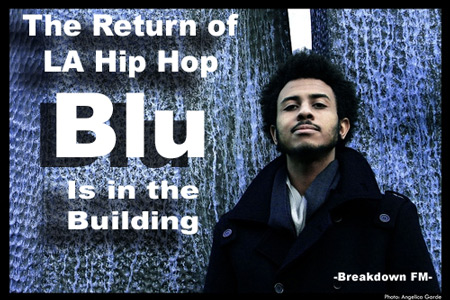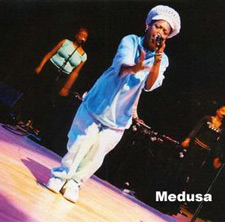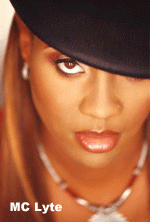Lady Of Rage surprises everyone at Snoop show (interview)
By Rebecca McDonald in 5 Questions, rap/hip hop
http://blogs.citypages.com/gimmenoise/2009/11/lady_of_rage_su.php?page=1

Lady of Rage (B-Fresh Photography)
You may know Lady Of Rage from her famous early-’90s hit single “Afro Puffs” that came out like a warning siren from a tough-as-nails sister and featured Snoop Dogg. Her deep, fearless voice bellowed through the speakers on said hit unexpectedly at Epic in Minneapolis on Thursday when Snoop surprised everyone with her introduction. It made the Wonderland High Tour truly memorable and had Twitter going crazy.
Lady of Rage has made quite an impact on hip-hop’s timeline with her lyrical style, but has been in hibernation cooking up her next album, Verbal Abuse. Even with her absence from the scene, there was no need for her to don a dark blue prison jumpsuit or have buff men dancing behind bars (circa 1995 Source Awards) to demonstrate how fierce she still is.
We sat down with her backstage to catch up on everything from her afro puff styling routine to female emcees, and putting to rest Internet rumors
CP: Such a pleasure to have you in the house. It was an unexpected surprise that you rolled through Minneapolis on this tour. What have you been up to?
LOR: I have been a hermit. I am creating. My new album coming out is called Verbal Abuse, and I want it to be right. My last album, Necessary Roughness, came out in a time when the empire was crumbling–Suge went to jail, Dre left, 2PAC was killed–everything was in shambles…. So this next project, I want it to be right. I want it the way the first one should have been done. And this will be my last one. Really, I am not motivated. I really don’t feel too much love–I will always love the rap game; but me loving to do it? It’s not what it used to be. The [music] that is out right now isn’t really motivational to me. There aren’t too many lyrics- just a bunch of hoopla.
CP: What do you feel is missing in Hip Hop?
LOR: Lyrics. I would like to see lyrical stuff–something that makes me say, “Wow. Did you hear what he/she just said?” to make me wanna go back and be like, “Oh naw, they can’t out-do me.” Make me want to step my game up. And I’m not hearing that.
CP: Looking back to the ’90s when you started out in the game, there were at least a few ladies making moves in hip-hop. So what is going on now? Where are the women at?
LOR: Well, I am baffled myself. I don’t know where they are. Trina, she is still relevant; I saw her on a video the other day. There is a new chick Nicki Minaj–I saw her in the same video with Trina. But other than that, you got me. I’m working on my stuff, you got Da Brat who can’t do anything at this time, Remy Martin with her situation. But you got Shawna, Rah Digga. You got Jean Grae. There are so many, but I don’t know what is going on! I don’t know if it’s a thing where we are so talented and so dope that people don’t know what to do with us, how to market us, or even how to handle us.
CP: What about a formal network of women coming together in hip hop to make moves? Have you been a part of anything like that?
LOR: Myself, Babs Bunny, and Lady Luck are trying to do something like that, coming together to form FEM (Females Earning Money). Right now it’s kind of on a hiatus, because we are all doing so many different things… We hope the best for the females, we want the females to come together. So many times we don’t come together. Females are catty, females are snotty. But we need to look at what the guys are doing–they get together, they collaborate, they make music, they keep it moving, and that’s what we should do. All that stereotypical nonsense with females–we need to flush it down the toilet… For the young ladies coming up, don’t be intimidated by the guys, don’t be intimidated by the industry… Let your talent speak for itself, and stick to your guns and your morals…
CP: We have to compliment you on your afro puff. What is your styling routine?
LOR: [Laughs] Wash it. Condition it. Brush it. Continuously puff it, pick it. I let it air dry. I use Blue Magic, water, a brush with sponge rollers.
CP: It’s been stated that you have been the hair dresser for Tha Dogg Pound (DPG). Is that true?
LOR: I have never been a hairdresser. I have never been a nurse. I saw that, too. I don’t know where that comes from! The same place saying I was gay comes from. Which I am none of the above. Never dabbled in hairdressing, never dabbled in nursing, and never dabbled in lesbianism. So never believe everything that you hear and see on the internet.













 If Hip Hop was your thing in the early 80’s there were a few things you understood: The hottest spot in the city at that time was Studio 54 in Manhattan, and you weren’t getting in there; but the club Disco Fever was in the Bronx; and if you wanted to be a legend in hip hop at that time, your ass had to play the Fever.
If Hip Hop was your thing in the early 80’s there were a few things you understood: The hottest spot in the city at that time was Studio 54 in Manhattan, and you weren’t getting in there; but the club Disco Fever was in the Bronx; and if you wanted to be a legend in hip hop at that time, your ass had to play the Fever. Mel couldn’t get in because initially, the club catered to an older audience. In the 60’s and early 70’s the Abbatiello family owned a jazz bar in the Bronx called the Salt and Pepper Lounge that catered to a mostly adult black clientele.
Mel couldn’t get in because initially, the club catered to an older audience. In the 60’s and early 70’s the Abbatiello family owned a jazz bar in the Bronx called the Salt and Pepper Lounge that catered to a mostly adult black clientele. “Well, one night I’m there at the club and I see Gee go into this routine, and I’m saying, “What in the fuck is Gee doing? He was saying things like “Throw your hands in the air and wave ’em like you just don’t care” and all of this other stuff and I’m looking at the crowd and I’m noticing that he’s bringing people together, and then it clicked: This is what the club needs. So I talked my dad into letting me have a night and after a while he agreed. He wasn’t sure about this rap stuff, but he let me try, so I went out to find the best: and that was a guy named Grandmaster Flash“.
“Well, one night I’m there at the club and I see Gee go into this routine, and I’m saying, “What in the fuck is Gee doing? He was saying things like “Throw your hands in the air and wave ’em like you just don’t care” and all of this other stuff and I’m looking at the crowd and I’m noticing that he’s bringing people together, and then it clicked: This is what the club needs. So I talked my dad into letting me have a night and after a while he agreed. He wasn’t sure about this rap stuff, but he let me try, so I went out to find the best: and that was a guy named Grandmaster Flash“. To be sure, hip-hop was not born in the Disco Fever, its birthplace is said to have been 1520 Sdgwick Ave. in the West Bronx. What the Fever was was the hot spot where the stars of that era went to chill and be seen in high fashion.
To be sure, hip-hop was not born in the Disco Fever, its birthplace is said to have been 1520 Sdgwick Ave. in the West Bronx. What the Fever was was the hot spot where the stars of that era went to chill and be seen in high fashion. “The Fever was like a second home to us”, said Mele Mel, “We could be overseas in Italy or Germany or somewhere like that and we would be calling the Fever, right into the deejay booth, and would be talking to Junebug on the phone, we would be like, “Yeah yeah, so what’s going on over there, who’s there tonight? If we were in New York, like say, the Roxy, we would hang out at the Roxy and then leave there at 3 or 4 o’clock in the morning and then go to the Fever when we were done. No matter where we were we always ended up back at the Fever.”
“The Fever was like a second home to us”, said Mele Mel, “We could be overseas in Italy or Germany or somewhere like that and we would be calling the Fever, right into the deejay booth, and would be talking to Junebug on the phone, we would be like, “Yeah yeah, so what’s going on over there, who’s there tonight? If we were in New York, like say, the Roxy, we would hang out at the Roxy and then leave there at 3 or 4 o’clock in the morning and then go to the Fever when we were done. No matter where we were we always ended up back at the Fever.” “As far as a club deejay – Junebug was a really nice”, says Grandmaster Caz, “But really, when I went there, I thought all of the disco deejays were the best there: Junebug, Starski, Starchild, but yeah, I have to say Junebug stood out. Sweet Gee was the host, he’d be the voice, he’d be biggin’ up everybody in the spot.”
“As far as a club deejay – Junebug was a really nice”, says Grandmaster Caz, “But really, when I went there, I thought all of the disco deejays were the best there: Junebug, Starski, Starchild, but yeah, I have to say Junebug stood out. Sweet Gee was the host, he’d be the voice, he’d be biggin’ up everybody in the spot.” “When I was first investigating the rap scene, Club 371 was one of the places I went to. When I went there I was in awe of this big fat guy, with this golden voice and he had absolute control over the crowd. He was the best entertainer ever; this guy rapped and sang, he mixed, he was a star, I mean a real star, even back then: his name was D.J. Hollywood. He had a Spanish deejay that used to spin for him named Junebug; I wanted both of them at my club. At first, only Junebug came over, but Hollywood didn’t; it took a long time to get him [Hollywood] to come over. He didn’t think the Fever was the right spot for him, I guess it was because he was used to playing for older adults who listened to a more R&B type music, he used to tell me “I don’t know man, I don’t think that’s my kinda crowd; but I’d tell him “Yo, all you gotta do is come on down and play for them. They’ll love you”, said Sal.
“When I was first investigating the rap scene, Club 371 was one of the places I went to. When I went there I was in awe of this big fat guy, with this golden voice and he had absolute control over the crowd. He was the best entertainer ever; this guy rapped and sang, he mixed, he was a star, I mean a real star, even back then: his name was D.J. Hollywood. He had a Spanish deejay that used to spin for him named Junebug; I wanted both of them at my club. At first, only Junebug came over, but Hollywood didn’t; it took a long time to get him [Hollywood] to come over. He didn’t think the Fever was the right spot for him, I guess it was because he was used to playing for older adults who listened to a more R&B type music, he used to tell me “I don’t know man, I don’t think that’s my kinda crowd; but I’d tell him “Yo, all you gotta do is come on down and play for them. They’ll love you”, said Sal. “I watched them from early that afternoon when they were like, these two total amateurs who were too scared to be on stage, to that night at the Fever, when they turned that place out. I saw D and Joey become: RUN-DMC, right before my eyes, and I’ll never forget it. They were rookies coming into that night but they were superstars by the end of the night – that’s how fast they transformed”, said an emphatic Spyder D.
“I watched them from early that afternoon when they were like, these two total amateurs who were too scared to be on stage, to that night at the Fever, when they turned that place out. I saw D and Joey become: RUN-DMC, right before my eyes, and I’ll never forget it. They were rookies coming into that night but they were superstars by the end of the night – that’s how fast they transformed”, said an emphatic Spyder D. Between 1976 and 1983, guys like Mele Mel and Lovebug Starski were the toast of the streets. They ruled in the period before trunk jewels and the bling era. They were ghetto celebs at a moment when hip-hop wasn’t fabulous. Time and circumstance cheated them out of the pot of gold that is said to over the rainbow. When their reign came to an end, so did the Fever’s. Every generation has that moment in time when their youth is celebrated, when their child-like innocence becomes the food of legend, before grown-up realities create jaded adults. Today, men well into their forties get misty-eyed when they recall their heyday of twenty-five years before. They weren’t ready to leave the scene, but time dictated that they must.
Between 1976 and 1983, guys like Mele Mel and Lovebug Starski were the toast of the streets. They ruled in the period before trunk jewels and the bling era. They were ghetto celebs at a moment when hip-hop wasn’t fabulous. Time and circumstance cheated them out of the pot of gold that is said to over the rainbow. When their reign came to an end, so did the Fever’s. Every generation has that moment in time when their youth is celebrated, when their child-like innocence becomes the food of legend, before grown-up realities create jaded adults. Today, men well into their forties get misty-eyed when they recall their heyday of twenty-five years before. They weren’t ready to leave the scene, but time dictated that they must. NEW YORK (Billboard) –
NEW YORK (Billboard) – 





 Long before it was acceptable to sing while you rapped, Medusa was out in the fore-front alongside artists like Lauryn Hill,Queen Latifah and the Force MDs who came before them who were paving the way by including harmonies and melodies with their raps and re-introducing that style to the Hip Hop audience.
Long before it was acceptable to sing while you rapped, Medusa was out in the fore-front alongside artists like Lauryn Hill,Queen Latifah and the Force MDs who came before them who were paving the way by including harmonies and melodies with their raps and re-introducing that style to the Hip Hop audience.




